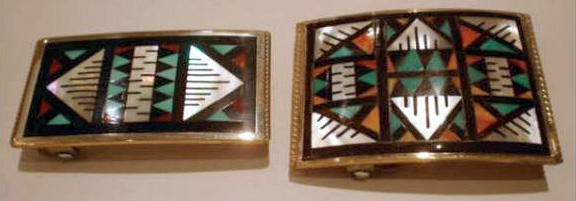 |
 |
 |
 Vallarta Living | Art Talk | October 2007 Vallarta Living | Art Talk | October 2007  
Fake Art Harms American Indian Artists
 Joseph Dits - South Bend Tribune Joseph Dits - South Bend Tribune
go to original


| Which of these pieces of jewelry was made by a Zuni Indian artist from New Mexico and which was copied overseas? Answer: The one on the left is the real deal. The Council for Indigenous Arts and Culture uses examples like this to protect the work of authentic artists.

|
Tony Eriacho erects his display beneath an outdoor canopy where artists sell fine carvings in Zuni, N.M.

He wants you to see what's eating at their livelihood.

So he reaches for a small board bedecked with multicolored pieces of hard candy. Or so they appear.

He dares you: Which of these are real gemstones that you might find in American Indian art? And which are synthetic fakes from a factory?

Uhh. You see no difference.

That's just his point.

These days, fakes in the American Indian art world look so much like the real thing that customers are being fooled. And the real artists are losing out on income.

That's critical on a reservation where making jewelry is the key industry and where elders put unemployment at 70 percent.

"If we don't protect our livelihood, we'll end up in Wal-Mart," says Eriacho, vice president of a group with a Hoosier tie that advocates against fake art and educates the public on buying the authentic stuff.

Indian artists, Eriacho laments, have found their own original art copied without their OK. The fakes typically come out of Asian factories, many of them in the Philippines, he says.

It even happened to his wife, a jewelry maker. They stumbled upon the copies about six years ago at flea markets in Albuquerque, N.M., and Phoenix.

There are laws to safeguard. They take vigilance, some of which you'll find in Pam Phillips, who for 30 years has run her Skystone 'n' Silver art/jewelry store in Hobart, Ind.

"The (wrong) assumption people make is if you buy it out West, it's authentic, or if you buy from a dealer, it's authentic," says Phillips, a founding board member of Eriacho's group, the Council for Indigenous Arts and Culture.

The Internet is flooded with fakes. So are many catalogs, Phillips says. Scrutinize what you find in powwows, too, she says. Fakes can easily appear there, along with items that aren't American Indian, such as mandalas - round objects with intricate designs that hale from Far Eastern countries.

She says you won't go wrong at an Indian art expo that the council will host Saturday and Sunday in Merrillville, Ind. You'll meet real artists, watch them at work and learn about authentic art.

Phillips is the only non-New Mexican and the only non-Indian on the council's board, but she grew up departing northwest Indiana for the Southwest each summer, where she'd hang out with her grandpa and his Indian friends. There, she learned to make jewelry and cut gemstones. She started a habit of picking up rare books about Indian history. She collected relationships with people who knew the art.

She kept wandering the reservations as an adult. Today, she says, Indian artists come to her home to study antique books that document burial practices, music and a wealth of other cultural history.

The safest way to ensure that art is authentic is to buy directly from an artist. It's also a lot more gratifying.

Even then, Eriacho advises, ask questions.

Ask where the art was made, what it's made of and how it was made. Ask for the artist's name and tribe. Ask the seller to put this in writing, including a signature. A receipt is helpful, too, with the full business name and address.

Sellers of fake art likely won't want to provide this. If the art proves to be fake, such documents could be used to sue the seller, Eriacho says.

A federal law, the 2000 Indian Arts and Crafts Enforcement Act, makes it illegal to falsely suggest the product being sold is made by an American Indian.

But Phillips says there's a loophole in another federal law, a Customs law. It states that imports must bear a permanent hallmark with the country of origin: "Made in ..." If the item cannot bear that, then it should have a tag or sticker saying the same, the law states.

Too many items come into the country with just the tag or sticker - which are easily removed once they're here, Phillips says.

She argues that the makers are perfectly able to stamp a permanent mark, especially if, for example, it's jewelry that already bears the word "sterling" or a vague set of initials. That brings up a gimmick that Eriacho says is used by the fake makers. He flips over jewelry engraved with "BY." It suggests an artist's initials, but it's likely made in the Philippines.

Eriacho says there's no good estimate on how much money is lost to the fake industry.

The state of New Mexico, where art and Indian culture help to drive the tourist economy, however, has started a task force to look into the issue of authenticity, he says.

On the Zuni reservation, a lot of people work out of their ever-so-simple homes to make jewelry, an art form that has gained Zuni a national reputation. Phyllis Albert says she earns a survivable income with her 12-hour days. She says a lot of other residents barely make the equivalent of minimum wage.

"A lot of them," she says, "are not lucky like I am to have a husband who works full time."

Joseph Dits: jdits@sbtinfo.com | 
 | |
 |



